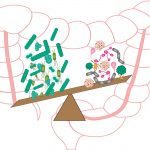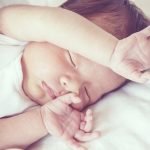The ECS in Childhood Diseases
JAKE F. FELICE, ND, LMP
Mention of the endocannabinoid system (ECS) often brings to mind cannabis and its major constituent, tetrahydrocannabinol (THC), which binds the cannabinoid-1 (CB1) receptor. These receptors are expressed mainly in neural tissue, where they lead to psychoactive effects, whereas CB2 receptors are expressed largely in immune cells and do not stimulate psychoactivity.1,2
A major limitation to the therapeutic effectiveness of THC-based cannabinoid therapy in children is the psychoactive effects of activating the CB1 receptor. Because the CB2 receptor lacks psychoactivity but still possesses immune-modulating and anti-inflammatory effects, the CB2 receptor represents a potentially ideal pharmacologic target to address ECS imbalances in children.
Non-THC cannabinoids, including cannabidiol (CBD), as well as ECS-modulating botanicals other than cannabis, can provide clinicians non-THC tools with which to address ECS imbalances. Many natural compounds bind to and activate the CB2 receptor, including alkylamides in echinacea3 and the anti-inflammatory terpene beta-caryophyllene, found in lemongrass, black pepper, copaiba oil, clove, hops, and many others botanicals.4,5 These natural compounds can selectively stimulate and modulate the ECS via the CB2 receptor while avoiding psychoactive stimulation at the CB1 receptor.6 Again, it is important to note that the modulation of the ECS does not have to involve psychoactivity or active stimulation of the CB1 receptor by THC in cannabis, and that other non-cannabis botanicals can play an active role in modulating the ECS via CB2 and other receptors.
The wide distribution of CB2 receptors on immune cells1 makes the ECS a natural candidate for the exploration of new treatment options for pediatric diseases involving inflammation and autoimmunity. Current evidence strongly suggests that cannabinoids modulate the activity of B-cells, T-cells, monocytes, and other immune cells, creating an environment that reduces inflammatory cytokines and increases anti-inflammatory cytokines.7
THC in Pediatrics?
Currently, the American Academy of Pediatrics (AAP) opposes the use of “medical marijuana” to treat adolescents and children, unless it is in the form of patented, FDA-approved treatment options, such as dronabinol (synthetic THC) and Epidiolex (plant-derived CBD).8 However, the organization acknowledges that cannabis may be considered for children with debilitating or life-threatening conditions for whom conventional drugs are inadequately treating their conditions.8-10
The ECS plays a critical role in brain development, beginning as early as the embryonic stage of life.11 In the developing human, however, external stimulation of the ECS by THC can interfere with the intricate signaling cascades necessary for proper brain development and maturation.8 The ECS and brain continue to develop throughout adolescence.8 Studies of teenagers who regularly consume THC have revealed changes in the cortex as well as impairments in areas such as executive functioning, verbal intelligence, impulsiveness, decision-making, and attention.8It is thus very clear that in a medically-well child, THC should be avoided so that the development-enhancing processes of the ECS can proceed normally, leading to a mature and healthy nervous system.11
Certain difficult-to-treat childhood diseases, however, can also dramatically impact the development of children, along with their quality of life. Examples include epilepsy,12 autism,13,14 celiac disease,15 inflammatory bowel disease,16-18 and immune thrombocytopenia.19-21
As will be documented in this review, a growing body of research indicates that many of these challenging pediatric conditions involve notable disruptions in endocannabinoid system functioning and that ECS modulation, especially via the non-psychoactive CB2 receptor, could be therapeutic.
It is therefore not an appropriate analogy to compare healthy teens using THC-rich cannabis (that might alter their normal development) with severely ill pediatric patients using CBD-rich cannabis who have not been tolerating or responding to conventional treatment, especially when an underlying cause of their condition might lie within the ECS.
Furthermore, many pharmacologic drugs, including anti-epileptic drugs, can be debilitating in their own right, including causing developmental delays,22 liver and other organ damage, lethargy, and even, ironically, inducement of seizures.23,24
Hemp-derived CBD is already known to possess anticonvulsant, anti-tumor, anti-inflammatory, antioxidant, antipsychotic, and anxiolytic properties.1 Furthermore, unlike THC, CBD does not cause a head high and does not induce tolerance,1 making it a potentially more promising agent for pediatric patients.
In the field, practitioners are seeing children with uncontrolled seizures, cognitive dysfunction, delayed development, and otherwise very poor prognoses improve following the initiation of cannabinoid therapy, including reduced frequency of seizures, improvements in appetite, alertness, sleep, eye contact, and quality of life, and reduced use of pharmacologic medication.25,26
Pediatrician Bonnie Goldstein, MD, reports that frequency of seizure reduction is only part of the goal when treating epilepsy with cannabinoids, and that some of her patients “do not show up as seizure reduction statistics because the frequency of [their] seizures hasn’t gone down, but severity and recovery time have gone down.”26 She also states, “The ultimate goal for pediatric epilepsy patients is freedom from seizure and the side effects of the [anti-epileptic drugs]. Interestingly, many parents whose children are having success with CBD oil to treat epilepsy are also reporting that their children have improved sleep, improved appetite, more alertness, and developmental progression. It is these other beneficial effects that make CBD a wonderful option for children suffering with seizures.”26
Pediatricians, patients, and families must balance the decision to use medical cannabis with its potential risks. All the conditions discussed in this article can profoundly affect the quality of life of kids and their families. These diseases also present a significant burden to the healthcare system.
Studies are still needed that examine the long-term effects of CBD. And more research is required to determine the degree to which the prevention or alleviation of disrupted ECS physiology associated with these diseases can lead to clinical improvements in them.
Cannabinoids in Specific Disorders
Backing up a bit, the endocannabinoid system (ECS) functions as a self-regulating, harm-reduction system that profoundly influences a multitude of physiologic processes in the human body and in almost all other mammals.1 The ECS consists of not only the cannabinoid receptors CB1 and CB2, but also endogenous ligands known as endocannabinoids (including their transport mechanisms), such as anandamide (AEA) and 2-arachidonoylglycerol (2-AG), and the endocannabinoid-metabolizing enzymes FAAH and MAGL, which degrade AEA and 2-AG, respectively. In addition to CB1 and CB2 receptors, endocannabinoids also modulate several other pathways and receptors, including TRPV1, GPR-55, and others.1,7,27,28
One of the primary functions of the ECS is to maintain homeostasis,1,29,30 partly through the production of endocannabinoid molecules. Researchers are beginning to understand that an imbalance in this system can result in dysfunction that may impact clinical disorders.31 A growing body of evidence indicates that some degree of ECS dysfunction is often present in children with epilepsy, autism, and other hard-to-treat conditions, including chemotherapy-induced nausea and vomiting, idiopathic thrombocytopenia purpura, inflammatory bowel disease, celiac disease, juvenile idiopathic arthritis, and spasticity.
Epilepsy
Approximately one-third of epilepsy patients have a treatment-resistant form of the disease.32 Currently, at least 11 studies indicate significant therapeutic efficacy using cannabinoids in patients with seizures.8 At least 8 of these studies looked at the effects of CBD specifically, including 1 randomized controlled trial (RCT). A small but robust number of pediatric studies, including RCTs, showed effectiveness of CBD and oral cannabinoids in reducing seizures, including in treatment-refractory epilepsy.8 Many of these studies showed a greater than 50% reduction in seizures, with 3 small studies showing more than an 80% reduction.8
The FDA-approved CBD isolate, Epidiolex, has been recognized for the treatment of epilepsy in children. Among epileptic patients who received CBD in an open-label intervention trial, seizure frequency decreased by 54%.32
Autism
Autism spectrum disorder (ASD) includes a group of developmental disabilities whose cause remains largely unknown.
Two small pediatric studies demonstrated lower levels of the endocannabinoids AEA and palmitoylethanolamide (PEA), as well as lower oleoylethanolamide (OEA, an AEA analog), in autistic children.33,34
Zou et al examined the ECS in a valproic-acid-induced animal model of autism and in ASD children.35 Both groups demonstrated reduced ECS signaling, upregulation of cannabinoid receptors, and an increase in endocannabinoid-degrading enzymes.35 Monoacylglycerol lipase (MAGL) is a hydrolytic enzyme that breaks down endocannabinoids. After introduction of a selective inhibitor of MAGL, 2-AG levels increased, and hyperactivity, cognitive functioning, and sociability improved in both the animals and the children.35 The investigators also found that children with lower levels of PEA displayed more serious symptoms of ASD.35
Interestingly, Kelly et al, in a study looking for early biomarkers of ASD in children, found that kids with poor communication skills at 3 years of age also exhibited dysregulated endocannabinoid levels 2 years earlier, at age 1.36 The authors suggested that endocannabinoids “may provide alternative approaches for early diagnosis of ASD, as well as insights into the pathobiology of these conditions.”36
It is interesting to note for future studies that plasma endocannabinoid concentrations can reflect brain levels and can be potential markers in prospective translational studies to help monitor disease progression and therapeutic responses in epilepsy.37
A glycosylated vitamin-D-binding protein that activates macrophages has demonstrated positive results in autistic children.38 Interestingly, blood monocyte-derived macrophages from autistic children show upregulated CB2 receptors (CB2R).38 The authors stated, “These data point to a potential nexus between endocannabinoids, vitamin D and its transporter proteins, and the immune dysregulations observed with autism. … It also seems likely that the CB2R is a potential therapeutic target for autism spectrum disorder interventions.”38
Spasticity
One small retrospective chart review of children in a palliative care setting for treatment-refractory spasticity showed a reduction in spasticity following THC administration.8 This study continued for a median of >180 days and showed no habituation. Additionally, in adults, 2 systematic reviews and one RCT concluded that oral cannabinoids benefit patient-reported spasticity.8
Inflammatory Bowel Disease
Inflammatory bowel disease (IBD) comprises autoimmune-mediated inflammatory conditions of the colon and small intestine, including ulcerative colitis and Crohn’s disease. There have been anecdotal reports over the years that cannabis species can ameliorate IBD symptoms such as nausea, diarrhea, and abdominal pain.39 This may be due to the fact that the gastrointestinal (GI) tract is rich in endocannabinoid receptors.
A number of studies have indicated that hyper-expression of cannabinoid receptors,40 elevated AEA,41 altered endocannabinoid-degrading enzymes,42 and impaired T-cell activation43 are involved in GI inflammation. A study by Massa et al revealed that blockage of the CB1 receptor, as well as genetic knockout of the endocannabinoid-degrading enzyme FAAH, can be protective against murine colitis.42
GI inflammation also appears to involve the endocannabinoid 2-AG and its degrading enzyme MAGL (which influences 2-AG levels). In another mouse model of colitis, inhibition of this enzyme was shown to reduce GI inflammation.44 Interleukin-8 (IL-8) is thought to play a role in IBD pathogenesis.45 A study of colonic epithelial cells revealed increased CB2 expression in acute IBD along with reduced IL-8, suggesting a role for the ECS in inflammatory diseases of the colon.45
Celiac Disease
Although more studies are needed, ECS dysregulation may be implicated in celiac disease (CD). In a study of over 300 children with CD, researchers found a statistically significant correlation between a variant of the CB2 receptor (Q63A) and CD, suggesting a role for the ECS in this condition.46 The authors of this study stated, “We provide here further evidence that CB2 receptor plays a critical role in autoimmunity susceptibility and indicates that it represents a molecular target to pharmacologically modulate the immune components in CD.” During active disease processes, an increase in CB2 has been observed in biopsied atrophic villi and the duodenal mucosa of celiac patients.47 Interestingly, CB2 expression can be seen during active CD; however, these levels appear to be normal in CD patients who are undergoing treatment.47
Juvenile Idiopathic Arthritis
Juvenile idiopathic arthritis (JIA) is a rare type of the rheumatoid arthritis (RA) that normally affects adults. Characteristics of JIA include inflammation, bone disruption, and joint pain.48 A study of Italian children, including healthy controls and patients with JIA, showed that those with a particular phenotype for the gene coding for CB2 have an increased risk of developing JIA, and that this variant is also linked with the clinical course of this disease.49
Interestingly, ECS elements are present in the synovium of adult RA patients but are absent in healthy synovial fluid.50 These elements of the ECS include elevated cannabinoid receptors CB1 and CB2, as well as the presence of 2-AG, AEA, and the AEA-degrading enzyme FAAH, none of which is present in healthy tissue.50 In a mouse model, MacDougall et al showed that FAAH inhibition (which would act to increase AEA) reduces inflammation in RA.51 It is worth noting that CBD causes FAAH inhibition as well.1
It is also most interesting that cyclooxygenase (COX) inhibitors, a mainstay of RA treatment, have also been shown to inhibit FAAH,52 and synergistic activities of COX-2 inhibitors and AEA have been described in animal pain models.53 These findings suggest that nonsteroidal anti-inflammatory drugs (NSAIDs) may selectively target the ECS, and should encourage more research, as these interactions may be of great clinical importance.
Another mouse study, examining collagen-induced arthritis, demonstrated that a selective CB2 agonist can change macrophage expression from proinflammatory to anti-inflammatory, thereby reducing inflammation.54 Meanwhile, in a study examining synovial fibroblasts from RA patients as well as induced RA in a rat model, a CB2 agonist was found to strongly prevent interleukin (IL)-1ß from inducing proinflammatory IL-6, IL-8, and COX-2, possibly via effects on the glucocorticoid receptor.55
The CB2 receptor also appears to influence bone erosion.56-58 In RA, bone erosions result from osteoclastic bone resorption at the sites of synovial inflammation, where the osteoclastic mediator RANKL is also found. Expression of RANKL, a nuclear factor-kappa B ligand, drives osteoclastic bone degradation.59 Increases in RANKL can be seen in autoimmune arthritis,60 and a reduction in RANKL has been observed after CB2 stimulation.61
Considering the debilitating effects of JIA on children’s development, the findings discussed here may indicate an important role for the non-psychoactive CB2 receptor and the ECS in both JIA and RA.
Immune Thrombocytopenia
Immune thrombocytopenia (ITP) is an autoimmune condition that often develops after a viral infection in which the immune process has disrupted platelets. A number of studies have described a correlation between an IL-10 polymorphism (-1082) and pediatric ITP.62-65 Activation of both CB1 and CB2 receptors stimulates IL-10 production, further confirming the ECS’ anti-inflammatory and immune-modulating properties.65,66
In ITP, the normal ability of mesenchymal stem cells (MSC) to proliferate and inhibit B-cells and T-cells becomes compromised.67 Interestingly, the CB2 receptor is more robustly expressed in MSCs of healthy children than in those of children with ITP.68 Moreover, when CB2 receptors are stimulated, the immune-modulating ability of MSCs is reestablished.68
In ITP, platelet survival and maturation are impacted. The endocannabinoids AEA and 2-AG modulate platelet survival and function, and AEA, specifically, can limit apoptosis in platelets, while 2-AG stimulates MSC production.69 Gasperi et al concluded that the endocannabinoid “2-AG, by triggering megakaryocyte maturation and platelet release, may have clinical efficacy to counteract thrombocytopenia-related diseases.”69 These platelet-modulating effects are enhanced when the 2-AG-degrading enzyme, MAGL, is inhibited, leading to higher levels of 2-AG and increased immune modulation via the ECS.69
Chemotherapy-Induced Nausea & Vomiting
At least 4 double-blinded RCTs and 2 non-RCT studies in children have shown cannabinoids to bring about significant improvements in chemotherapy-induced nausea and vomiting (CINV) in children.8 Although side effects of sleepiness and dizziness were reported, studies indicate that THC is more efficacious for vomiting than traditional anti-emetics, including domperidone and metoclopramide.8 This parallels the results of a large number of anti-emetic trials in adults.8
A number of studies evaluating the use of cannabinoids in the treatment of CINV have demonstrated decreased nausea and vomiting in children administered THC.8 These studies include double-blind crossover RCTs in which cannabinoids out-performed conventional anti-nausea medication.8 In one study, cannabinoid therapy reduced retching and vomiting by 70%. In comparison, the anti-emetic agent, prochlorperazine, reduced symptoms by only 30%.8
Conclusion
Evidence-based data regarding the medical use of cannabis in children is still limited; much more research is needed in this area. However, research to date is very encouraging. Targeting the ECS via the non-psychoactive CB2 receptor, including with the use of several natural agents, gives clinicians potential non-psychoactive and low-toxicity modalities to address ECS imbalances in both pediatric and adult populations. Further exploration of the ECS and associated natural therapies will greatly enhance practitioners’ ability to effectively address these difficult-to-treat childhood conditions.
References:
- Corroon J, Felice JF. The endocannabinoid system and its modulation by cannabidiol (CBD). Altern Ther Health Med. 2019;25(S2):6-14.
- Malan TP Jr, Ibrahim MM, Lai J, et al. CB2 cannabinoid receptor agonists: pain relief without psychoactive effects? Curr Opin Pharmacol. 2003;3(1):62-67.
- Raduner S, Majewska A, Chen JZ, et al. Alkylamides from Echinacea are a new class of cannabinomimetics: Cannabinoid type 2 receptor-dependent and -independent immunomodulatory effects. J Biol Chem. 2006;281(20):14192-14206.
- Russo EB. Beyond Cannabis: Plants and the Endocannabinoid System. Trends Pharmacol Sci. 2016;37(7):594-605.
- Russo EB. Taming THC: Potential cannabis synergy and phytocannabinoid-terpenoid entourage effects. Br J Pharmacol. 2011;163(7):1344-1364.
- Aly E, Khajah MA, Masocha W. β-caryophyllene, a CB2-receptor-selective phytocannabinoid, suppresses mechanical allodynia in a mouse model of antiretroviral-induced neuropathic pain. Molecules. 2020;25(1):106.
- Katz D, Katz I, Porat-Katz BS, Shoenfeld Y. Medical cannabis: Another piece in the mosaic of autoimmunity? Clin Pharmacol Ther. 2017;101(2):230-238.
- Wong SS, Wilens TE. Medical Cannabinoids in Children and Adolescents: A Systematic Review. Pediatrics. 2017;140(5):e20171818.
- Simonian JS, Varanasi S, Nguyen A van, et al. A critical narrative review of medical cannabis in pediatrics beyond epilepsy, part I: background. Pediatr Med. 2020;3:14.
- Committee on Substance Abuse, Committee on Adolescence; Committee on Substance Abuse Committee on Adolescence. The impact of marijuana policies on youth: clinical, research, and legal update. Pediatrics. 2015;135(3):584-587.
- Fride E, Gobshtis N, Dahan H, et al. The endocannabinoid system during development: emphasis on perinatal events and delayed effects. Vitam Horm. 2009;81:139-158.
- Pellock JM. Understanding co-morbidities affecting children with epilepsy. Neurology. 2004;62(5 Suppl 2):S17-S23.
- Miller LE, Burke JD, Robins DL, Fein DA. Diagnosing Autism Spectrum Disorder in Children with Low Mental Age. J Autism Dev Disord. 2019;49(3):1080-1095.
- Lord C, Brugha TS, Charman T, et al. Autism spectrum disorder. Nat Rev Dis Primers. 2020;6(1):5.
- Kelly CP, Bai JC, Liu E, Leffler DA. Advances in diagnosis and management of celiac disease. Gastroenterology. 2015;148(6):1175-1186.
- Stanford Children’s Health. Crohn’s Disease. 2021. Available at: https://www.stanfordchildrens.org/en/service/inflammatory-bowel-disease/crohns-disease. Accessed June 22, 2021.
- Baldassano R, Ferry G, Griffiths A, et al. Transition of the patient with inflammatory bowel disease from pediatric to adult care: recommendations of the North American society for pediatric gastroenterology, hepatology and nutrition. J Pediatr Gastroenterol Nutr. 2002;34(3):245-248.
- Motil KJ, Grand RJ, Davis-Kraft L, et al. Growth failure in children with inflammatory bowel disease: a prospective study. Gastroenterology. 1993;105(3):681-691.
- Cooper N, Cines DB. The child with immune thrombocytopenia: To treat or not to treat, is that still the question? Haematologica. 2019;104(11):2132-2134.
- Booth IW, Aukett MA. Iron deficiency anaemia in infancy and early childhood. Arch Dis Child. 1997;76(6):549-554.
- Ibrahim R, Khan A, Raza S, et al. Triad of iron deficiency anemia, severe thrombocytopenia and menorrhagia–a case report and literature review. Clin Med Insights Case Rep. 2012;5:23-27.
- Meador KJ, Loring DW. Developmental effects of antiepileptic drugs and the need for improved regulations. Neurology. 2016;86(3):297-306.
- Bauer J. Seizure-inducing effects of antiepileptic drugs: a review. Acta Neurol Scand. 1996;94(6):367-377.
- Perucca P, Gilliam FG. Adverse effects of antiepileptic drugs. Lancet Neurol. 2012;11(9):792-802.
- Raucci U, Pietrafusa N, Paolino MC, et al. Cannabidiol Treatment for Refractory Epilepsies in Pediatrics. Front Pharmacol. 2020;11:586110.
- Goldstein B. Cannabis in the Treatment of Pediatric Epilepsy: The Author Documents the Progress of More than 100 Patients Using CBD-Rich Cannabis Oil to Treat Seizure Disorders. O’Shaughnessy’s. Winter 2015/16.
- Maccarrone M, Bab I, Bíró T, et al. Endocannabinoid signaling at the periphery: 50 years after THC. Trends Pharmacol Sci. 2015;36(5):277-296.
- Oláh A, Szekanecz Z, Bíró T. Targeting cannabinoid signaling in the immune system: “High”-ly exciting questions, possibilities, and challenges. Front Immunol. 2017;8:1487.
- Felice JF. The Endocannabinoid System : Self-Regulating Harm Protection. NDNR. 2018;14(7):1,3. Available at: https://ndnr.com/pain-medicine/the-endocannabinoid-system-self-regulating-harm-protection/. Accessed June 18, 2021.
- de Laurentiis A, Fernández Solari J, Mohn C, et al. Endocannabinoid system participates in neuroendocrine control of homeostasis. Neuroimmunomodulation. 2010;17(3):153-156.
- Russo EB. Clinical Endocannabinoid Deficiency Reconsidered: Current Research Supports the Theory in Migraine, Fibromyalgia, Irritable Bowel, and Other Treatment-Resistant Syndromes. Cannabis Cannabinoid Res. 2016;1(1):154-165.
- Devinsky O, Marsh E, Friedman D, et al. Cannabidiol in patients with treatment-resistant epilepsy: an open-label interventional trial. Lancet Neurol. 2016;15(3):270-278.
- Karhson DS, Krasinska KM, Dallaire JA, et al. Plasma anandamide concentrations are lower in children with autism spectrum disorder. Mol Autism. 2018;9:18.
- Aran A, Eylon M, Harel M, et al. Lower circulating endocannabinoid levels in children with autism spectrum disorder. Mol Autism. 2019;10:2.
- Zou M, Liu Y, Xie S, et al. Alterations of the endocannabinoid system and its therapeutic potential in autism spectrum disorder. Open Biol. 2021;11(2):200306.
- Kelly RS, Boulin A, Laranjo N, et al. Metabolomics and Communication Skills Development in Children; Evidence from the Ages and Stages Questionnaire. Metabolites. 2019;9(3):42.
- Lerner R, Post J, Loch S, et al. Targeting brain and peripheral plasticity of the lipidome in acute kainic acid-induced epileptic seizures in mice via quantitative mass spectrometry. Biochim Biophys Acta Mol Cell Biol Lipids. 2017;1862(2):255-267.
- Siniscalco D, Bradstreet JJ, Cirillo A, Antonucci N. The in vitro GcMAF effects on endocannabinoid system transcriptionomics, receptor formation, and cell activity of autism-derived macrophages. J Neuroinflammation. 2014;11:78.
- Uranga JA, Vera G, Abalo R. Cannabinoid pharmacology and therapy in gut disorders. Biochem Pharmacol. 2018;157:134-147.
- di Marzo V, Izzo AA. Endocannabinoid overactivity and intestinal inflammation. Gut. 2006;55(10):1373-1376.
- D’Argenio G, Valenti M, Scaglione G, et al. Up‐regulation of anandamide levels as an endogenous mechanism and a pharmacological strategy to limit colon inflammation. FASEB J. 2006;20(3):568-570.
- Massa F, Marsicano G, Hermann H, et al. The endogenous cannabinoid system protects against colonic inflammation. J Clin Invest. 2004;113(8):1202-1209.
- Chen ML, Sundrud MS. Cytokine networks and T-cell subsets in inflammatory bowel diseases. Inflamm Bowel Dis. 2016;22(5):1157-1167.
- Alhouayek M, Lambert DM, Delzenne NM, et al. Increasing endogenous 2‐arachidonoylglycerol levels counteracts colitis and related systemic inflammation. FASEB J. 2011;25(8):2711-2721.
- Wright K, Rooney N, Feeney M, et al. Differential expression of cannabinoid receptors in the human colon: Cannabinoids promote epithelial wound healing. Gastroenterology. 2005;129(2):437-453.
- Rossi F, Bellini G, Tolone C, et al. The Cannabinoid Receptor type 2 Q63R variant increases the risk of celiac disease: implication for a novel molecular biomarker and future therapeutic intervention. Pharmacol Res. 2012;66(1):88-94.
- Battista N, di Sabatino A, di Tommaso M, et al. Altered expression of type-1 and type-2 cannabinoid receptors in celiac disease. PLoS One. 2013;8(4):e62078.
- Wasserman AM. Diagnosis and management of rheumatoid arthritis. Am Fam Physician. 2011;84(11):1245-1252.
- Bellini G, Olivieri AN, Grandone A, et al. Association between cannabinoid receptor type 2 Q63R variant and oligo/polyarticular juvenile idiopathic arthritis. Scand J Rheumatol. 2015;44(4):284-287.
- Richardson D, Pearson RG, Kurian N, et al. Characterisation of the cannabinoid receptor system in synovial tissue and fluid in patients with osteoarthritis and rheumatoid arthritis. Arthritis Res Ther. 2008;10(2):R43.
- McDougall JJ, Muley MM, Philpott HT, et al. Early blockade of joint inflammation with a fatty acid amide hydrolase inhibitor decreases end-stage osteoarthritis pain and peripheral neuropathy in mice. Arthritis Res Ther. 2017;19(1):106.
- Fowler CJ, Janson U, Johnson RM, et al. Inhibition of anandamide hydrolysis by the enantiomers of ibuprofen, ketorolac, and flurbiprofen. Arch Biochem Biophys. 1999;362(2):191-196.
- Guindon J, Beaulieu P. Antihyperalgesic effects of local injections of anandamide, ibuprofen, rofecoxib and their combinations in a model of neuropathic pain. Neuropharmacology. 2006;50(7):814-823.
- Falconer J, Murphy AN, Young SP, et al. Review: Synovial Cell Metabolism and Chronic Inflammation in Rheumatoid Arthritis. Arthritis Rheumatol. 2018;70(7):984-999.
- Fechtner S, Singh AK, Srivastava I, et al. Cannabinoid Receptor 2 Agonist JWH-015 Inhibits Interleukin-1β-Induced Inflammation in Rheumatoid Arthritis Synovial Fibroblasts and in Adjuvant Induced Arthritis Rat via Glucocorticoid Receptor. Front Immunol. 2019;10:1027.
- Idris AI, Van’t Hof RJ, Greig IR, et al. Regulation of bone mass, bone loss and osteoclast activity by cannabinoid receptors. Nat Med. 2005;11(7):774-779.
- Ofek O, Attar-Namdar M, Kram V, et al. CB2 cannabinoid receptor targets mitogenic Gi protein-cyclin D1 axis in osteoblasts. J Bone Miner Res. 2011;26(2):308-316.
- Rossi F, Tortora C, Punzo F, et al. The endocannabinoid/endovanilloid system in bone: From osteoporosis to osteosarcoma. Int J Mol Sci. 2019;20(8):1919.
- Boyce BF, Xiu Y, Li J, et al. NF-κB-mediated regulation of osteoclastogenesis. Endocrinol Metab. 2015;30(1):35-44.
- Tyrovola JB, Spyropoulos MN, Makou M, Perrea D. Root resorption and the OPG/RANKL/RANK system: a mini review. J Oral Sci. 2008;50(4):367-376.
- Rossi F, Bellini G, Tortora C, et al. CB2 and TRPV1 receptors oppositely modulate in vitro human osteoblast activity. Pharmacol Res. 2015;99:194-201.
- Tesse R, del Vecchio GC, de Mattia D, et al. Association of interleukin-(IL)10 haplotypes and serum IL-10 levels in the progression of childhood immune thrombocytopenic purpura. Gene. 2012;505(1):53-56.
- Saitoh T, Kasamatsu T, Inoue M, et al. Interleukin-10 gene polymorphism reflects the severity of chronic immune thrombocytopenia in Japanese patients. Int J Lab Hematol. 2011;33(5):526-532.
- Ou Y, Yang Y, Xiang X, Wu Y. Relationship between the IL-10 (−1082 A/G) polymorphism and the risk of immune/idiopathic thrombocytopenic purpura: A meta-analysis. Cytokine. 2020;125:154820.
- Soliman MA, Helwa MA, Fath-Allah SK, et al. IL-10 polymorphisms and T-cell subsets could affect the clinical presentation and outcome of childhood immune thrombocytopenia in Egyptian population. APMIS. 2018;126(5):380-388.
- Robinson RH, Meissler JJ, Fan X, et al. A CB2-Selective Cannabinoid Suppresses T-Cell Activities and Increases Tregs and IL-10. J Neuroimmune Pharmacol. 2015;10(2):318-332.
- Gao F, Chiu SM, Motan DA, et al. Mesenchymal stem cells and immunomodulation: Current status and future prospects. Cell Death Dis. 2016;7(1):e2062.
- Rossi F, Tortora C, Palumbo G, et al. Cb2 receptor stimulation and dexamethasone restore the anti-inflammatory and immune-regulatory properties of mesenchymal stromal cells of children with immune thrombocytopenia. Int J Mol Sci. 2019;20(5):1049.
- Gasperi V, Avigliano L, Evangelista D, et al. 2-Arachidonoylglycerol enhances platelet formation from human megakaryoblasts. Cell Cycle. 2014;13(24):3938-3947.

Jake F. Felice, ND, LMP is a cannabis author, clinician, educator, and consultant whose vision is to advance the science and practical application of cannabis for medical and recreational markets around the world. Dr Felice provides world-class educational experiences by speaking authentically about hemp and cannabis. He consults with healthcare providers, industry, and the general public. His Category 1 CME courses for doctors, nurses, and pharmacists has been translated into 4 languages. Dr Felice is the founder of Cannabis Matrix Consulting, LLC, and he maintains a regular cannabis blog at drjakefelice.com.









